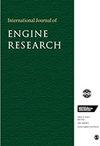二冲程航空活塞发动机气缸体的耦合分析
IF 2.1
4区 工程技术
Q2 ENGINEERING, MECHANICAL
引用次数: 0
摘要
铝合金缸体是航空活塞发动机的部件,长期处于热机械耦合状态下工作,容易产生疲劳裂纹。建立某型发动机的 GT-POWER 仿真模型,验证模型的准确性,通过模型得到发动机缸体在恶劣工况下的温度、压力等边界参数,并根据发动机工况将缸壁划分梯度,得到缸体的表面传热系数,进而得到发动机机体的温度场分布。对恶劣工况下发动机缸体的爆缸压力和温度场进行耦合分析,结果表明发动机缸体的最大应力为 292.55 MPa,最大变形量为 0.39 mm,其中热负荷是导致变形的主要因素。进行发动机整机台架试验,在 1000 h 的台架耐久试验下,发动机缸体没有出现裂纹,说明设计和分析符合要求。本文章由计算机程序翻译,如有差异,请以英文原文为准。
Coupling analysis of cylinder block for two-stroke aviation piston engine
The aluminum alloy block is a component of aircraft piston engine, and it is prone to fatigue cracks when working in a thermal mechanical coupling state for a long time. Establish a GT-POWER simulation model for a certain type of engine, verify the accuracy of the model, obtain boundary parameters such as temperature and pressure of the engine block under harsh operating conditions through the model, and divide the cylinder wall into gradients based on the engine operating conditions to obtain the surface heat transfer coefficient of the block, and then obtain the temperature field distribution of the engine body. The coupling analysis of the cylinder burst pressure and temperature field of the engine block under harsh working conditions showed that the maximum stress of the engine block was 292.55 MPa and the maximum deformation was 0.39 mm, with thermal load being the main factor causing deformation. Conduct a complete engine bench test, and under the 1000 h bench durability test, there are no cracks on the engine block, indicating that the design and analysis meet the requirements.
求助全文
通过发布文献求助,成功后即可免费获取论文全文。
去求助
来源期刊

International Journal of Engine Research
工程技术-工程:机械
CiteScore
6.50
自引率
16.00%
发文量
130
审稿时长
>12 weeks
期刊介绍:
The International Journal of Engine Research publishes high quality papers on experimental and analytical studies of engine technology.
 求助内容:
求助内容: 应助结果提醒方式:
应助结果提醒方式:


